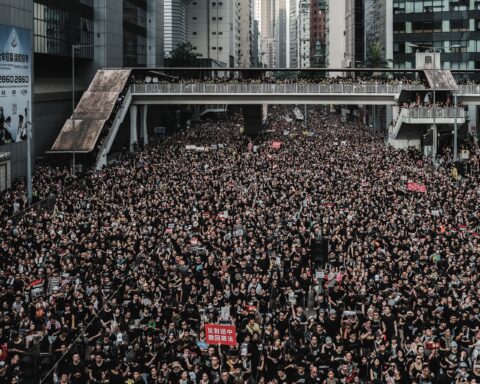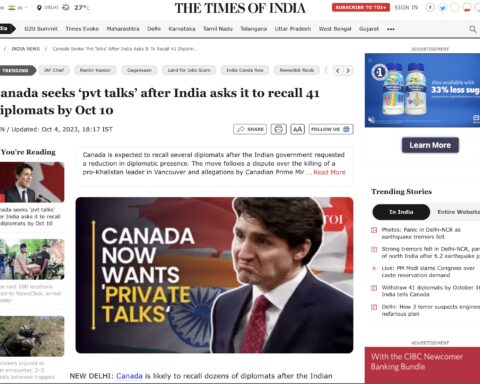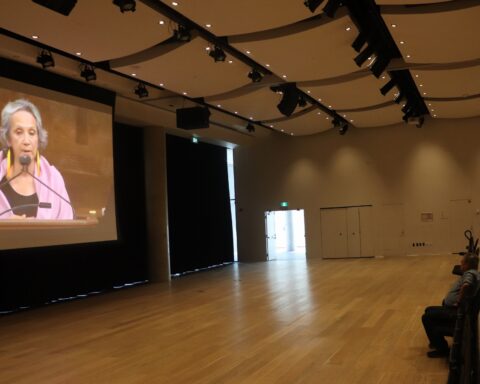Though it can be criticised as lip service, the Canadian government’s ongoing ‘dialogue’ on human rights with China sometimes has a bite.
This was evident last week when China’s touchy foreign minister threw a temper tantrum at a press conference in Ottawa when questioned about Beijing’s dismal human rights record.
The current practice calls for Canadian ministers to confine human rights discussions to private meetings with their Chinese counterparts. But as much as Canada has failed at curbing Beijing’s habit of executing dissidents and suppressing minorities such as Tibetans and Uighurs, China has failed at trapping the issue to government chambers sealed behind closed doors.
Thus every time the world’s economic dragon fumes at being bridled by ‘Western’ values, the issue of human rights gains more ink in the Sino-Canada storyline.
So what should Canada’s terms of engagement be with world’s next rising economic star, the current elephant-in-heat India?
Last year, India’s economy sprinted ahead to post a world-beating 7.6% GDP growth rate, though this result seems wind-aided thanks to some artful statistical spackling of poor data.
And as with China, this top-of-the-class economic report card has not spawned a halo effect to remove attention from the subcontinent’s own poor human rights record. In the foreground of the recently-stalled Canada-India free trade talks are ongoing protests by Canada’s politically influential South Asian community calling for protection of minorities in India.
These boiled at high heat last April when walls of protesters confronted India’s Prime Minister Narendra Modi upon landing for his official state visit to Canada, dogging him from Ottawa to Toronto, and to Vancouver.
Human rights violations are again casting a shadow over Modi’s state visit this week to the United States where he will be addressing a joint session of the US Congress. Even though India is being feted by the West as a counterweight to rising Chinese assertiveness in Asia, US elected officials are also petitioning for change in how the Indian government treats minority Christians, Muslims, and Sikhs. This includes a group of 34 senators and congressmen penned a letter recently urging the Prime Minister to ‘hold perpetrators of this violence to account’.
These episodes of bloodshed include the infamous 2002 Gujarat riots in which hundreds of Muslims were killed by Hindu mobs and in which Modi was allegedly complicit – an event that led him to be denied a visa to the United States in 2005.
For Canada’s one million strong Sikh population, justice remains outstanding in the targeted killings of thousands of Sikhs in Delhi in 1984, along with the earlier attacks on the Golden Temple when hundreds of innocent worshippers on pilgrimage were shot down by Indian soldiers. The failure to convict the organisers of the Delhi mass killings and resolve this violent chapter against India’s Sikh minority – which like Christians in India form a mere 2% of the population – has allowed the wounds to grow toxic.
Although official reports record the killings of nearly 3,000 Sikhs, unofficial estimates are as high as 30,000. According to Barbara Crossette, a former New York Times bureau chief in New Delhi, “Almost as many Sikhs died in a few days in India in 1984 than all the deaths and disappearances in Chile during the 17-year military rule of Gen. Augusto Pinochet between 1973 and 1990,”
And so this past weekend on Saturday, Sikhs in Vancouver again gathered at the downtown Art Gallery to hold a vigil for victims of these events. This is the first of two annual commemorative events – the second, the annual Sikh Nation Blood Drive is held in November to mark the Delhi killings. It is the largest third party blood drive in the country for Canadian Blood Services.
Now in his early 20’s, Manveer Singh has worked as an organiser for the art gallery vigil. Like others of his generation, he was born outside of India and after the 1984 atrocities. Yet the horror of these events spared few – virtually every family knew of someone who was murdered or was a casualty of violence. These wounds have filtered into the current generation through emotional osmosis.
For Singh, Canada’s aspiration to expand its trade relationship with a state that refuses to account for the blood on its hands undermines Canadian values.
“At the political level, there is a reluctance to address these past events and press for convictions in the Delhi genocide as this would anger the Indian government,” said Singh in reference to the Canadian government averting its eyes from India’s record of violence towards minorities.
“What pains us most is that those from India’s Congress Party who were behind the killings still live free with impunity,” added Singh, who is currently a university student in Vancouver.
The future lies to the west over the Pacific for both Canada and the United States. North American companies have pivoted towards Asia – the next evolutionary step beyond NAFTA is the Trans Pacific Partnership, a free trade agreement between the US, Canada, Mexico and seven Asian nations that is looking to include India in its next stage.
In this ever unfettered global economy, uranium dug out from the Prairies is today shipped across the Pacific to power India’s nuclear power plants and feed its energy starved population. But in this same environment of capital and labour mobility, blood spilled in Delhi thirty years ago can stain the earth red in Canada today.
The Sikh community in Canada is politically potent, punches above its weight, and stands to be a key arbiter in the future of companies like Saskatchewan-based Cameco, which last year signed a $350 million deal in 2015 to provide uranium for India’s reactors. For Canadian resource companies seeking to reach India’s 1.2 billion consumers, they may find their caravans blocked by the ghosts of 1984 that haunt this new silk-road connecting cities like Vancouver, Saskatoon, and Toronto to Asia’s new El Dorado.
A number of Canadian elected officials have attempted to lay these spirits to rest by seeking official recognition of the Delhi killings as a genocide in order to close the chapter and move forward.
In 2011, MP Sukh Dhaliwal was the first to raise this topic at an official federal level. The member from Surrey-Newton put forward a petition in the House of Commons for official recognition of the 1984 killings as an act of genocide, plowing ahead with the convictions of his constituents despite a rebuke from then Liberal party leader Michael Ignatieff, as well as the Indian consulate in Vancouver. Dhaliwal received support from current Minister of Innovation, Navdeep Bains.
When asked if he would re-submit a proposal, Dhaliwal stated, “I was happy to forward petitions on behalf of my constituents, and now with e-petitions as a new way to facilitate grassroots democracy, I will continue to advance the petitions that are submitted by Surrey-Newton residents.”
NDP leader, Tom Mulcair has also issued an official release on the matter, stating that he and the federal NDP “firmly stand in solidarity with the community, independent human rights organizations and Canadians across the country, in seeking justice”.
And just this past week a motion for recognition of the Delhi killings as a genocidal act was voted on in the Ontario house. Put forward by Ontario NDP MLA Jagmeet Singh, it was defeated by the Liberal majority.
Singh tweeted afterwards, “By voting against the Sikh Genocide Recognition motion the Liberals turned their back on human rights, justice, reconciliation & healing. They not only turned their backs on the Sikhs but all the Hindu & Muslim families who risked their lives to save their Sikh neighbours.”
The World Sikh Organisation (WSO), the activist organisation that contributed mightily to Justin Trudeau’s victory, also expressed its disappointment at the defeat of MLA Jagmeet Singh’s bill. “We also call for justice for the victims of 1984, and that those who were behind the attacks need to be brought to justice instead of being allowed to live free with impunity,” said WSO legal counsel Balpreet Singh, adding the organisation supported Sukh Dhaliwal’s petition.
With 16 MP’s of Sikh heritage in the House of Commons, this matter will not fade into the recesses of the past. The recent recognition of the Armenian genocide by the German government as well as the apology for the Komagata Maru incident have bolstered confidence of achieving genocide recognition from Canada’s Sikh community.
Even the Government of India’s Nanavati Commission Report acknowledges “but for the backing and help of influential and resourceful persons, killing of Sikhs so swiftly and in large numbers could not have happened.”
Despite such a damning statement, the Indian government has yet to move on convictions against the senior Congress Party members who organised the attacks.
Last year, Canada’s then-Conservative government’s Minister of Foreign Affairs issued a statement on the anniversary of China sending in the tanks against the protesters in Tiananmen Square, “Canada urges China to break its silence on the events of 26 years ago by openly accounting for the people who were killed, detained or went missing and by launching a process of national healing and reconciliation.”
The Canadian government has yet to make an equivalent request to India for its Tiananmen moment, when its tanks crackled over the marble promenade of the Golden Temple in 1984 and when senior Congress Party officials ordered police to stand down while sword-wielding mobs cut down thousands of innocent people.
With discussions of free trade in the air, the timing is right for that statement. It stands to be a rare moment where investing in the fight for human rights would provide a good return for business.
Jagdeesh Mann is executive editor of the South Asian Post based in Vancouver. Twitter: @JagdeeshMann. An abridged version of this was first published in The Globe & Mail.
This commentary was republished with permission from the South Asian Post
Jagagdeesh Mann is a Vancouver-based entrepreneur and a founding partner of the Asian Pacific Post, a Jack Webster Award–winning publication. His work has been published by the Toronto Star, the Georgia Straight, the Globe and Mail, the CBC, and Canadaland.





The Sikhs have to assess the PLIGHT of their enemy which is Bania Brahmin Brigade of the Indian State !
THE INDIANS ARE DOING ONLINE YOGA AND LOOKING FOR PIA BALLOONS AND THEREFORE – THEY HAVE BEEN ATTACJED BY 2 DRONES YESTERDAY – WHICH BOMBED THEIR IAF AIRBASES !
https://www.reuters.com/world/india/india-probes-suspected-use-drones-blast-jammu-air-base-officials-2021-06-27/
HOW CAN THE WORLD USE INDAIN VAXES ? HOW CAN INDIA HAVE AN AIRFORCE ? HOW CAN INDIANS BE IN THE QUAD ! THEY CAN’T SAVE THEIR PLANES – HOW WILL THEY SAVE THEIR PEOPLE !
This is another false flag ! A drone came from AK, 10 kms into Hindoosthan,via the IB/LC and all the pandoos of the BSF,ADS and the IAF were sleeping !
The attack was at NIGHT – so there was NO VISUAL SIGNATURE.
Y did the Drones miss ? Did they come to blow a hole in the roof of a building ? How could they miss the Choppers and Jets ? What about the Fuel Dumps ?
UAVIED = IED Force Multiplier ! A small payload can cause more damage than a ICBM – as the payload can be targetted TO A SPECIFIC EXPONENTIAL TARGET (like ammo dumps,fuel dumps,jets loaded with fuel and ammo ….)
Sat pictures of the IAF base would be known to the Mujahideen,and so,the GPS coordinates WILL GUIDE THE DRONE TO THE TARGET ! So Y did the drone miss ?
So the Drone was NOT GPS tuned,and was a basic drone ! Y will a basic drone be used, unless it be tracked to drop payload at a target ? The only STEALTH WAY to do the same – is via a camera, which transmits at set intervals (so that IAF jammers,do NOT intercept the transmission)
The fact that the Drone entered the IAF base and was on ATC zone, means that the handler could see the target ! AND SO Y DID THE HANDLER DROP THE CHARGE AT THE WRONG TARGET ? There was no drone recovered by the Indians – SO THE DRONE DID NOT MALFUNCTION – and so,Y was the payload dropped ?
It is simple ! It was a false flag ! Done by RAW and MOSSAD,to fund the DRONE DEFENSE TECHNOLOGY,TO BE SOLD BY ISRAEL,TO INDIA ! THE ISRAELI TECHNOLOGY IS USELESS FOR INDIA! THE DRONES USED BY THE KASHMIRI FREEDOM FIGHTERS IN INDIA,ARE SMALL DRONES, WHICH HAVE NO RCS AND NO INFRA RED OR THERMAL SIGNATURE – AND CARRY A VERY SMALL PAYLOAD
Hamas DRONES were large with heavy payloads,and slow,with a set trajectory !
Indian Drones are based on the “IED Force Multiplier” concept ! The key in India is TARGET SELECTION – then getting the drone to HIT the target,is easy meat – especially at Nights with cloud cover and a dark moon ! If the small drones fly even at 10000 feet – radars will not detect the same !Tree Top cruising is the last option,for the mujahideen !
So the Israeli technology will not work, in India !
The Solution to jammers used by the Indians, is saturation drones,at the same time but attacking from different coordinates.In addition,once the drones are 50 -100 meters from the target – all radio frequency and visual transmission needs to be cut off, and the handler has to use time and distance to plan the drop – by 1 last transmission, at an unknown frequency !
Once the drone RCS is minimised,then drones at a height of even 500 feet,will be invisible to radar and the human eye – even in the day ! Then just one last visual relay from the drone is required – to release the payload – like the WW2 bombers – were bombs were manually dropped from 20000 feet – AND THIS IS 500 FEET ! And if this happens at NIGHT – then it is Gala Freedom! KAMIKAZE DRONES ARE NON-STOPPER !
Sooner rather than later,the UAVIEDs will reach the Naxals and the North East !
Take the example of Goa,IAF base in Dabolim Commercial Airport,Fuel Dumps for IAF,Navy and Railways – visible to the eye,Ports and Ships at Dock – visible to the eye,packed tourists in the open spaces,oil and naptha tankers docked at high seas ….
India has TO READ THE WRITING ON THE WALL ! Give Freedom to Kashmir and partition India !
The Indians DID NOT have the sense to have a ABR, in the form of a drone,at a height of even 1000 feet to scan all projectile movement – as a drone,has a SET TRAJECTORY AND PATH PATTERN AND A SET SPEED .Even then,the ABR MIGHT detect the drone,BUT WILL NOT BE ABLE TO STOP THE DRONE.NO ADS WORKS AT 50 TO 300 FEET – AS IT IS TOO CLOSE TO MISS.dindooohindoo